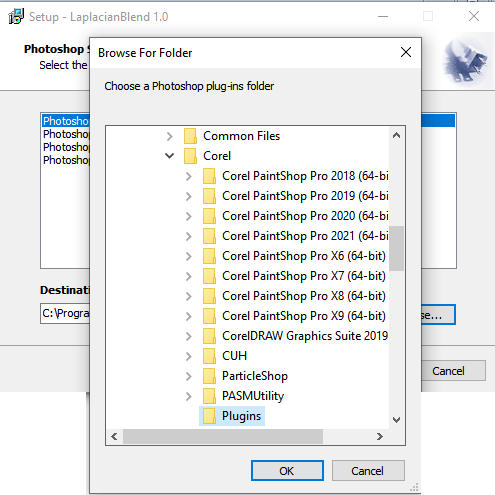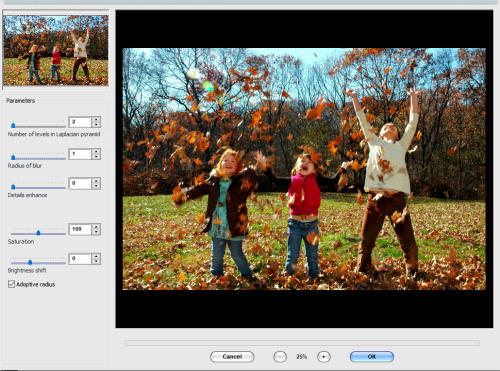As mentioned very often in the Campus, many plugins promoted or even labelled as "for Photoshop" can work just as well in PaintShop Pro. One just has to try. I have recently discovered a whole series of plugins that are totally new to me, and they might just be little gems for you, PaintShop Pro users. Today, I will present and explore the Laplacian Enhanced plugin.
Where to find it?
The Laplacian Enhanced is one of a series of plugins available from AlphaPlugins. It is totally free, so don't hesitate to grab it.
How to install it?
When you want to download this plugin, find the Windows link (because there is a separate link for Mac users). It will download an .exe file. Beware of the settings on your browser, if you have issues since some browsers or some settings are picky when it comes to downloading executable files. Also, if your browser just does not seem to work, try a different one. Using Chrome, no download would start, but using Firefox, it worked fine (maybe I have such a setting to check?)
When you have the .exe file, you will simply double-click on it to start the installation process. Then, after you accept the terms, you will be presented with a window similar to this one:

Notice that it is only looking for Photoshop installations. If you have Photoshop installed, it will find them. If you don't, that pane will be empty. Either way, you want to point the installation to PaintShop Pro, so you need to click on the Browse... button, and navigate to where plugins are installed in PaintShop Pro.

The proper location will be in the folder under Program Files > Corel > Plugin. This particular plugin won't work if you just put it in a different location and point PaintShop Pro to it through File location.
Now, you should see this plugin appear under the Effects menu:

How to use the Laplacian Enhanced plugin?
At this point, using the plugin is quite simple. Once you have a photo you want to use, simply open the plugin. You will be greeted with this interface:

I reset all the settings to minimum change so that you can see the base photo as a comparison.
The first setting, called Number of levels in Laplacian pyramid, does not seem to do much on its own, however, it will have an effect on the other settings. We'll see.
The next setting, Radius of blur will add a level of smoothness to the photo. Here is the comparison when it is set to 50 (with the Number of levels set to 6).

Now, let's add the third setting, Details enhanced. This will act a bit like the familiar Sharpen, in PaintShop Pro. And in combination with the previous settings, it will add that enhancement to your photo.

Those are the basic settings, and with different combinations, you can enhance your photos subtlely, or in a more aggressive way.

There are also two more settings, called Saturation and Brightness shift. Those are pretty self-explanatory and can yield results like these:

or this:

32-bits or 64-bits?
Knowing that this is a recent plugin (or at least, still maintained by the author), I initially installed the plugin in the Program Files folder, which is for any 64-bits version of PaintShop Pro. Since more than one version of PaintShop Pro can be installed in that folder, it means that all those versions will gain access to that plugin once installed in that manner. On the other hand, if you install it in the Program Files (x86), it will then be available in your 32-bits versions of PaintShop Pro.
Initially, when I installed the plugin in the Program Files (x86), it not appear in my older versions of PaintShop Pro (like X2). Checking the File Location, I noticed that, by default, the location listed for the plugins was C:\Program Files (x86)\Corel\Corel Paint Shop Pro Photo X2\Languages\EN\PlugIns. Obviously, that is not where I had installed it. When I added the path C:\Program Files (x86)\Corel\PlugIns to the list of folders, it worked fine in my PSPX2.
Considering that older versions, from JASC, were also 32-bits, I tried adding that location to the list of paths for plugins and sure enough, it also works in my old JASC PSP9. But don't mix and match the 32-bits and 64-bits. If you install the plugin in the Program Files (which is for 64-bits programs), don't point your 32-bits versions to it and vice versa.
This plugin can certainly help you enhance your photos or give them a specific look that you didn't manage to capture in the original photoshoot.
What will you do with this plugin? Show us some before and after photos in the forum.














11 thoughts on “Featured Resource – Laplacian Enhanced”
And on the site I saw the following text 🙂
This plug-in can be used not only with the Photoshop but and with many Photoshop compatible editors. For example, this article explains how to use the AlphaPlugins LaplacianEnhanced with Corel PaintShopPro. Thank Carole Asselin (from scrapbookcampus.com) for so illustrative and detail review how to isntall and use the plug-in for PhaintShopPro.
On my PC it is windows defender who blocks the whole site when you want to download something.
So still choosing Still to keep, you can manage it to download it in Edge.
Any plugin from the site.
Both Chrome and Edge blocks the download. In edge I could say I want to keep it anyway.
Good to know. Those browsers are getting pickier over time!
Had trouble trying to download with Chrome so had to switch to IE, Yes I still have that on my system. Will install when I have more time.
That description by Ann Seeber went over my head too.
Thank you Carole ! with your instructions I have been able to install the plugin en working on PSP 19 , 20, and 21 in the 32 and 64 bit versions.
Thank you! I never have much luck at downloading and installing any plug-ins, but your instructions were sooo fool proof—I did it! The plug-in shows up on both Pro 19 and 20, in the 32 and 64 bit versions. I am looking forward to taking this plug-in for a test drive. Woot woot!
I have just installed this plugin on Edge! Now I have to try it out, but it is already very late here! so it will have to wait till tomorrow. But I thought I let you now.
I like this program especially when combined with other fixes.
Carole says that Chrome fails on the download but also, be aware the download for the PDF doesn’t work in MS Edge, either. I copied it and took it to Firefox and that worked ok. Also true of the download for the Laplacian Enhanced on the Alpha Plugins site. So neither Chrome nor Edge will do the trick.
Never having seen the term Laplacian, I looked it up on good ole’ Google and got this: In mathematics, the Laplace operator or Laplacian is a differential operator given by the divergence of the gradient of a function on Euclidean space. It is usually denoted by the symbols ∇·∇, ∇² (where ∇ is the nabla operator) or Δ. In a Cartesian coordinate system, the Laplacian is given by the sum of second partial derivatives of the function with respect to each independent variable. In other coordinate systems, such as cylindrical and spherical coordinates, the Laplacian also has a useful form. Informally, the Laplacian Δf(p) of a function f at a point p measures by how much the average value of f over small spheres or balls centered at p deviates from f(p). Since I’m very deficient in math it’s no wonder I was “at sea.” 😉